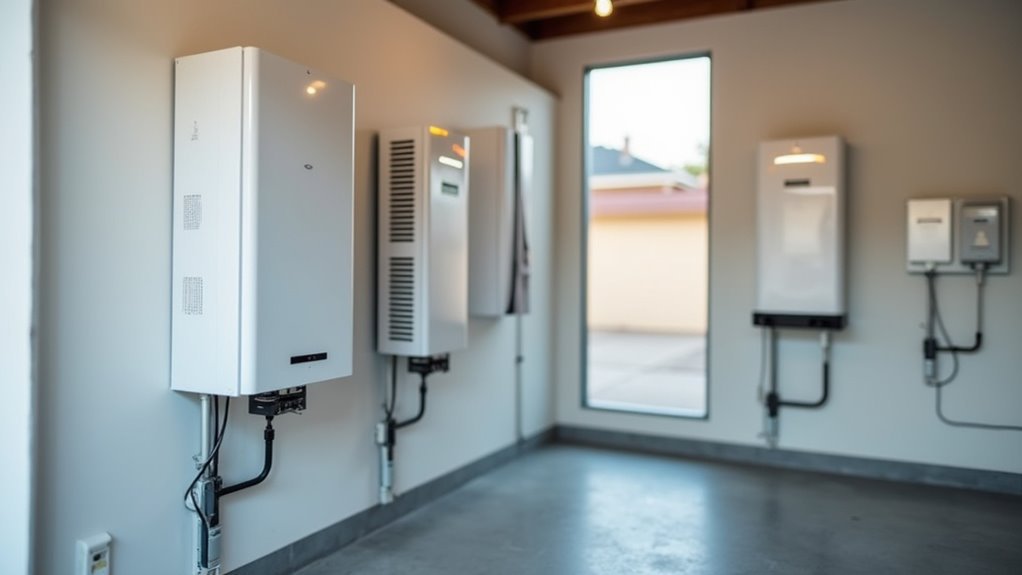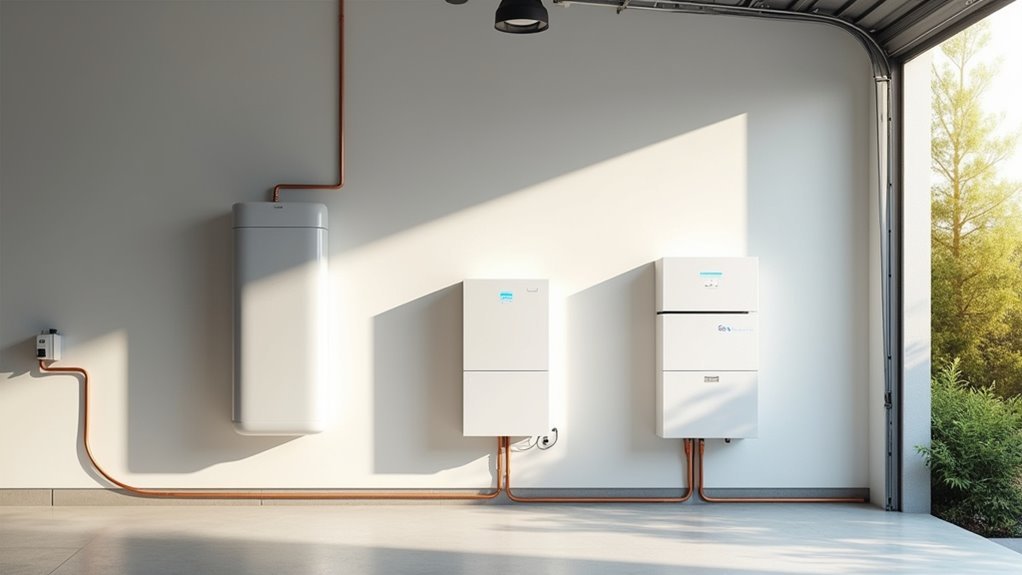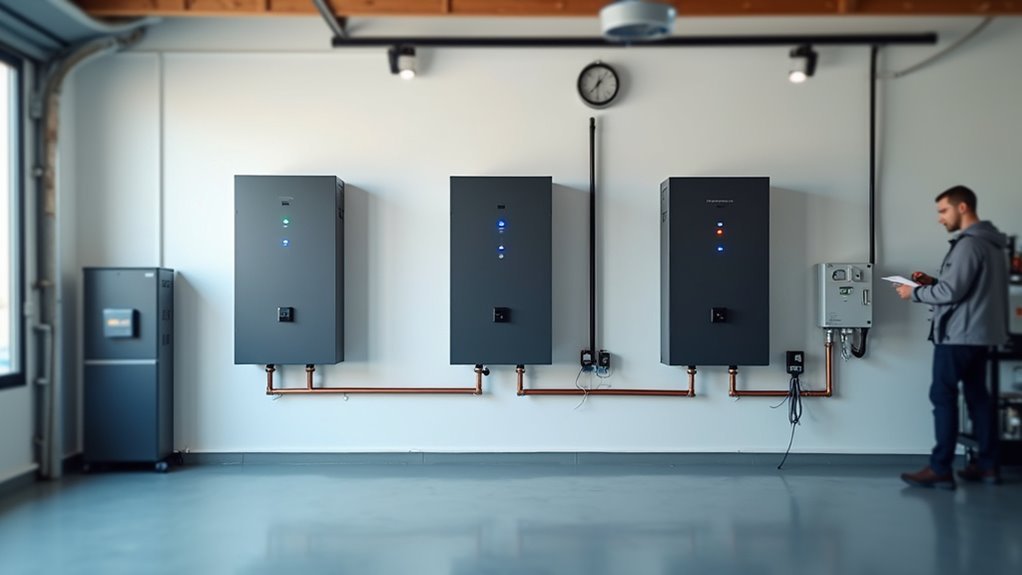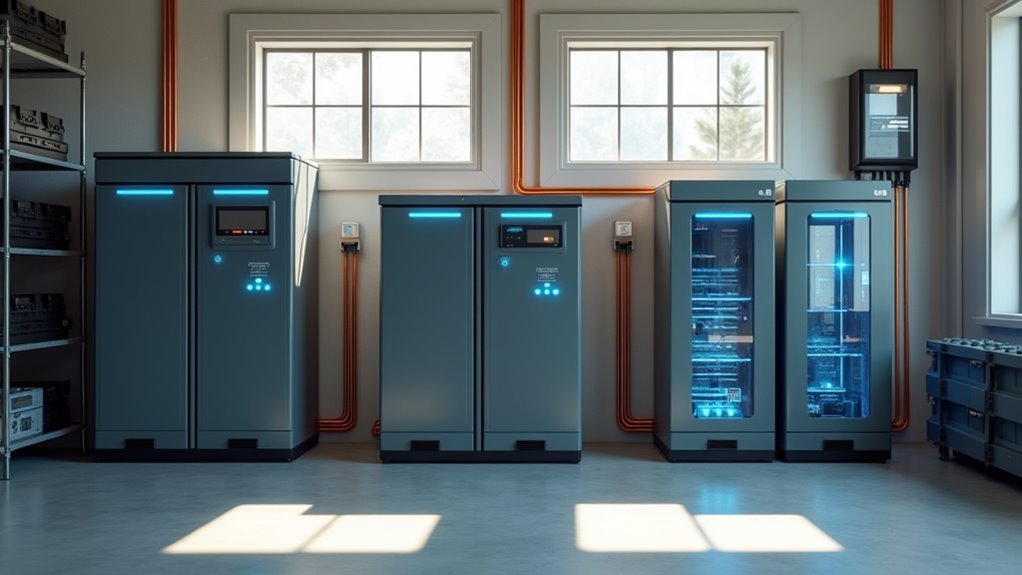You’re likely spending more on electricity than necessary, especially if you’re not capturing and storing the energy your home generates or receives during off-peak hours. Modern battery storage systems can dramatically shift this equation, but choosing between lithium-ion, LFP, and other emerging technologies isn’t straightforward. Each option presents unique trade-offs in capacity, lifespan, safety, and cost—decisions that’ll impact your energy independence and monthly bills for decades.
Understanding Home Battery Energy Storage Systems

When power outages strike or electricity rates peak during high-demand hours, home battery energy storage systems offer a reliable solution that’s transforming how you manage residential energy.
These systems function as large rechargeable batteries that store electricity for your home, providing power during outages while optimizing consumption during expensive peak periods.
Your battery systems include lithium-ion batteries, inverters for DC to AC conversion, and Battery Management Systems for monitoring and safety.
You’ll maximize energy independence by storing excess solar energy generated during the day for nighttime use.
While installation costs range from $10,000 to $25,000, you can offset expenses through federal tax credit incentives.
These energy storage systems reduce electricity costs and potentially cut your annual carbon emissions by 7-10 tons, delivering reliable home battery backup.
Solar-Plus-Battery Integration for Maximum Efficiency
When you combine solar panels with battery storage, you’ll achieve around 90% system efficiency while gaining complete energy independence from the grid.
You can maintain power during outages through islanding capability, ensuring your home stays operational when neighbors lose electricity.
Energy Storage Optimization
Solar-plus-battery systems revolutionize home energy management by capturing excess power during peak sunlight hours and storing it for later use during nighttime or outages. Your battery storage system achieves 90% round-trip efficiency, maximizing energy utilization while reducing grid dependency.
| Optimization Strategy | Annual Savings |
|---|---|
| Peak demand shaving | $200-300 |
| Time-of-use rates | $547.50 average |
| Grid independence | $400-600 |
| Backup power value | $150-250 |
| Carbon reduction | 7-10 tons CO₂ |
Smart Battery Management Systems automatically adjust storage cycles based on your energy consumption patterns. These energy management strategies optimize when your solar batteries charge and discharge, reducing peak demand costs. You’ll cut carbon emissions considerably while maintaining reliable backup power during outages.
Islanding Capability Benefits
Power independence becomes reality when your solar-plus-battery system automatically disconnects from the grid during outages, creating an isolated energy ecosystem that keeps your essential appliances running.
These islanding capabilities transform your home into a resilient energy fortress, particularly valuable if you’re in areas experiencing frequent power outages.
Your solar-plus-battery systems can sustain critical loads for hours or days without grid reliance, maximizing stored solar energy when you need it most.
The automatic disconnection feature protects utility workers by preventing dangerous backfeed while ensuring safe operation.
This integration enhances overall efficiency of your renewable systems, reducing dependence on traditional energy sources.
You’ll achieve true energy independence, turning potential blackouts into manageable inconveniences rather than major disruptions to your daily life.
Cost-Saving Strategies
Although grid independence provides security, your solar-plus-battery system’s true financial power emerges through strategic energy management that can slash your electricity bills by hundreds of dollars annually.
By storing excess solar panel energy during the day, you’ll discharge that power during expensive peak hours instead of buying grid electricity. Time-of-use rates amplify these cost-saving strategies—charge your battery when rates drop overnight, then use stored energy when prices spike.
Peak shaving reduces demand charges that penalize high usage periods. Smart energy management can cut annual costs by approximately $547.50 for typical homes.
The federal investment tax credit sweetens the deal, covering 30% of your battery system costs upfront.
Top Battery Technologies and Their Performance Metrics
When you’re evaluating battery technologies for your home energy storage system, you’ll need to understand how different lithium-ion types perform in real-world conditions.
Your system’s efficiency and power ratings directly impact which appliances you can run during outages and how much energy you’ll save over time.
The warranty terms you’ll receive vary greatly between battery technologies, making this comparison essential for protecting your long-term investment.
Lithium-Ion Battery Types
As the dominant force in home energy storage, lithium-ion batteries deliver exceptional energy density that’s perfectly suited for residential use, typically offering 10-20 kWh of capacity in a compact footprint.
You’ll find two primary types dominating the market, each with distinct advantages.
Lithium Iron Phosphate (LFP) batteries stand out for their exceptional safety profile and impressive longevity, delivering over 5,000 cycles for extended reliability.
They’re your best bet for long-term value and peace of mind.
Alternatively, Lithium Nickel Manganese Cobalt Oxide (NMC) batteries provide superior energy density but come with a shorter 500-cycle lifespan, making them less ideal for residential applications.
Both types achieve impressive 90% round-trip efficiency, minimizing energy waste.
You’ll appreciate their generous depth of discharge ratings of 80-90%, maximizing your usable energy capacity.
Efficiency and Power Ratings
Understanding battery chemistry provides the foundation, but efficiency and power ratings determine how well your energy storage system performs in real-world conditions.
You’ll want to focus on round-trip efficiency, which typically reaches 90% for quality solar batteries, meaning you’ll lose only 10% during energy storage cycles.
Pay attention to depth of discharge ratings, as premium batteries allow 90% utilization of total battery capacity without damage.
Your continuous power output needs will determine which system works best—options range from 3 kW to over 10 kW depending on household demands.
- Round-trip efficiency of 90% maximizes your energy storage investment returns
- High depth of discharge extends battery lifespan while providing usable capacity
- Continuous power ratings must match your simultaneous household load requirements
- Modular systems offer scalable battery capacity for future expansion needs
Warranty Coverage Comparison
While performance metrics matter, warranty terms often reveal manufacturers’ true confidence in their battery systems and directly impact your long-term investment value.
Most home battery systems offer warranties spanning 10 to 15 years, covering 4,000 to 8,000 cycles depending on the manufacturer. However, some solar batteries stand out with superior coverage.
The Tesla Powerwall 3 provides unlimited cycles, offering exceptional long-term value for your energy storage investment. SunPower’s SunVault similarly includes unlimited cycle warranties, emphasizing durability and cost-effectiveness.
The Enphase IQ Battery 5P maintains a solid 10-year warranty focused on reliability and performance. Franklin Home Power extends coverage to 12 years while supporting up to 15 batteries for scalable residential systems.
Cost Analysis: Investment vs. Long-Term Savings
When you’re evaluating battery solutions for your home, the upfront investment can seem substantial, but the long-term financial benefits often justify the initial expense.
Home battery systems typically cost $10,000 to $25,000 installed, but you’ll benefit from the 30% investment tax credit (ITC) that greatly reduces your actual costs. A 10 kWh system costs around $7,000 after federal credits, storing energy at approximately $999 per kWh.
You’ll see annual savings of up to $547.50 through strategic energy usage during peak pricing hours, creating long-term savings that offset your initial investment within years.
- Energy costs reduction through peak-hour arbitrage maximizes your battery’s financial value
- Federal incentives cut your upfront investment by thousands of dollars immediately
- Demand charge reduction programs offer additional revenue streams for savvy homeowners
- Strategic energy storage transforms monthly utility bills into predictable, manageable expenses
Capacity Planning for Your Home’s Energy Needs

Most homeowners consume 20 to 30 kWh of electricity daily, making this your starting point for determining the right battery capacity for your home.
Effective capacity planning requires understanding your power output needs by calculating essential appliances’ total wattage that must run simultaneously. You’ll want battery storage capable of sustaining critical loads for at least 24 hours, typically requiring 10 to 20 kWh for backup purposes.
Consider your battery’s depth of discharge rating—options with 90% or higher DoD let you utilize more stored energy without damage.
Analyze your peak demand periods to optimize time-of-use rates, storing energy during low-cost hours and discharging during expensive peak times. This strategic approach maximizes your daily energy consumption efficiency while ensuring adequate backup power.
Power Output Requirements and Load Management
When selecting a home battery system, you’ll need to understand the difference between peak power output (short bursts for high-demand appliances) and continuous power output (sustained energy delivery over time).
Your battery must handle essential loads like refrigerators and HVAC systems, which typically require 5-10 kW of continuous power during outages.
You’ll want to prioritize which appliances are truly essential since running everything simultaneously can quickly exceed your system’s capacity.
Peak Vs Continuous Power
Understanding your home’s power requirements starts with distinguishing between peak and continuous power output from battery systems.
Peak power represents the maximum burst capacity your battery delivers when starting energy-intensive appliances like air conditioners or refrigerators. Continuous power indicates sustained output over extended periods, essential for maintaining multiple devices simultaneously during outages.
Home battery systems typically provide 5-10 kW continuous power and 7-15 kW peak power. Effective load management requires matching your electricity demands with your battery’s capabilities to prevent system damage.
- Peak power handles initial appliance startup surges requiring temporary higher energy
- Continuous power maintains steady household operations throughout extended outages
- Proper sizing prevents overloading your battery beyond its safe operating limits
- Load prioritization guarantees critical appliances receive power when capacity becomes limited
Essential Load Prioritization
Smart battery management begins with prioritizing which appliances and systems you’ll power during outages.
Essential load prioritization involves identifying critical equipment like refrigeration, heating systems, and medical devices that must stay operational. Your battery system needs adequate continuous power output to handle these demands—typically 5 kW for average homes, while larger properties may require 10 kW or more.
Effective load management strategies help maximize your backup power duration.
You’ll want to stagger high-demand devices rather than running them simultaneously. For instance, avoid starting your air conditioner while your electric water heater’s cycling on.
Your battery’s peak power rating becomes vital when starting these appliances, as they often require considerably more power during startup than during normal operation.
Round-Trip Efficiency and Energy Loss Considerations

Since you’re investing in a solar battery system, you’ll want to maximize every kilowatt-hour you store, which makes round-trip efficiency a critical factor in your decision.
Most solar batteries achieve around 90% efficiency, meaning you’ll lose 10% of your stored energy during charging and discharging cycles. This energy loss occurs from internal resistance and DC-to-AC conversion through your inverter.
Consider a 10 kWh battery with 90% efficiency – you’ll only retrieve 9 kWh of usable energy. Battery systems with higher round-trip efficiency deliver better financial benefits over time.
Key efficiency considerations:
- Internal resistance causes heat-based energy losses during operation
- Inverter conversion from DC to AC reduces overall system efficiency
- Higher efficiency ratings translate to greater long-term savings
- Efficiency directly impacts your return on investment calculations
Modular vs. Integrated Battery System Designs
Beyond efficiency ratings, the physical design of your battery system considerably impacts both installation flexibility and future expansion options.
Modular systems use smaller interconnected battery modules, letting you customize capacity and upgrade storage without replacing everything. You’ll find these designs offer superior scalability—simply add more modules as your energy needs grow.
Integrated systems combine batteries and inverters into one compact unit, but they limit expansion flexibility since you’d need complete replacement for capacity increases.
While modular systems may cost more upfront due to multiple components, they provide better long-term value through tailored energy management.
Their customizable nature optimizes energy use more effectively than integrated systems, and reduced installation complexity over time often offsets initial investment costs.
Evaluating Warranty Terms and Cycle Life Expectations
Warranty coverage serves as your primary financial protection when investing in solar battery systems, with most manufacturers offering 10 to 15-year terms that guarantee 4,000 to 8,000 charge cycles.
When evaluating warranty terms, you’ll find lithium-ion batteries markedly outperform lead-acid alternatives, which only deliver 300 to 500 cycles. The depth of discharge directly impacts your usable energy and overall cycle life expectations.
- Check for unlimited cycle warranties that protect high-usage scenarios
- Verify throughput clauses specifying total energy output over the battery’s lifespan
- Confirm installation by certified professionals to maintain warranty validity
- Review conditions that could void coverage, including improper maintenance or unauthorized modifications
Understanding these warranty components helps you make informed decisions about long-term battery performance and value.
Federal Tax Credits and Local Incentive Programs
You’ll find significant financial relief through the federal investment tax credit (ITC), which lets you deduct 30% of your battery system’s cost from your federal taxes.
Your state likely offers additional rebate programs that can stack with federal benefits to further reduce your upfront investment.
You should research your local utility’s incentive programs since many provide time-of-use rate discounts and participation opportunities in virtual power plants that generate ongoing income.
Federal ITC Benefits
One of the most notable financial advantages of home battery systems comes through the federal investment tax credit (ITC), which allows you to deduct 30% of your total system costs directly from your federal tax bill.
This substantial reduction makes energy storage solutions much more accessible by cutting upfront expenses considerably. For example, a typical 10 kWh battery system costing $7,000 qualifies for approximately $2,100 in tax credits.
- Calculate your potential savings by multiplying total installation costs by 30%
- Combine federal credits with local utility incentives for maximum financial benefit
- Verify your system qualifies by meeting all ITC requirements and deadlines
- Explore net metering options alongside battery storage to optimize long-term savings
State Rebate Programs
While federal tax credits provide substantial savings, state rebate programs can dramatically reduce your battery system costs even further. Many states offer generous rebates that work alongside the federal investment tax credit (ITC), creating multiple stacking opportunities for savings.
These rebate programs vary considerably by location, with amounts determined by local policies and available budgets.
You’ll find some utilities offer innovative incentive programs like Bring Your Own Battery or Virtual Power Plants, where you’re compensated for allowing grid support through your home battery systems.
These programs typically provide upfront rebates or performance-based payments based on energy storage and discharge activities.
You should research your state’s energy office and utility company thoroughly, as these combined incentives can substantially reduce costs for both battery systems and solar installations.
Installation Requirements and Professional Setup Process
Since home battery installation involves complex electrical work and safety considerations, you’ll need to hire certified professionals to handle the setup process.
Installation requirements typically demand at least two electricians working several hours to a full day, depending on your system’s complexity. Before installation begins, professionals will conduct a site visit to assess your home’s suitability and existing electrical infrastructure.
Your battery system may require electrical upgrades like new inverters or circuit breakers to handle increased energy storage capabilities.
Professional setup costs start around $3,000, varying based on required modifications. You should gather multiple quotes from certified installers to compare options and explore available financing plans that can help manage upfront expenses.
- Schedule professional site assessment to determine ideal battery placement
- Budget for potential electrical system upgrades during installation
- Compare multiple installer quotes to find competitive pricing
- Research available financing options and federal/state incentives
Grid Independence and Islanding Capabilities
When power outages strike your neighborhood, a battery system with islanding capabilities automatically disconnects from the utility grid and continues powering your home independently. This grid independence guarantees you’ll maintain electricity for essential appliances during extended outages.
Solar-plus-battery systems excel at storing excess energy generated during sunny days, making it available when you need backup power most. Your battery energy storage can keep critical systems running for hours or even days, depending on your stored capacity and consumption patterns.
Beyond emergency situations, these systems offer daily benefits. You’ll reduce electricity bills by using stored energy during peak rate periods instead of purchasing expensive grid power.
This islanding capability transforms your home into a self-sufficient energy hub that operates seamlessly whether the grid’s available or not.
Time-of-Use Rate Optimization Strategies
As utility companies increasingly adopt Time-of-Use (TOU) rate structures, you can leverage battery storage to dramatically reduce your electricity costs by strategically timing when you consume grid power.
Your home battery system charges during off-peak hours when electricity rates are lowest, then discharges stored energy during expensive peak periods. This load shifting strategy helps you avoid premium pricing while maintaining normal energy consumption patterns.
Effective time-of-use optimization delivers measurable savings – homeowners can save approximately $547.50 annually through strategic energy management.
Your battery storage transforms volatile electricity rates into predictable energy costs.
- Charge batteries during low-rate off-peak hours to minimize energy costs
- Discharge stored energy during high-rate peak periods instead of purchasing expensive grid power
- Avoid peak demand penalties by drawing from your battery during consumption spikes
- Capitalize on electricity rate fluctuations to maximize financial benefits
Battery Safety Features and Monitoring Systems
While maximizing your energy savings remains important, protecting your investment through thorough safety systems takes priority in any battery storage installation. Modern battery management systems continuously monitor your system’s performance while protecting against overcharging and overheating. These safety features include thermal management protocols and fire-resistant enclosures that safeguard your home.
| Safety Component | Function |
|---|---|
| Battery Management Systems | Monitor performance and balance charging |
| Thermal Management | Prevent overheating and fire hazards |
| Ground Fault Protection | Mitigate electrical risks |
| Isolation Mechanisms | Prevent grid backfeeding during outages |
| Fire-Resistant Enclosures | Contain potential thermal events |
Advanced inverters provide real-time monitoring of battery health and energy usage, letting you track efficiency proactively. You’ll find compliance with industry standards like UL 9540 guarantees your system meets rigorous safety requirements for residential installations.
Frequently Asked Questions
How Long Will a 10KW Home Battery Last?
Your 10kW home battery’s duration depends on your energy consumption. If you’re using 2kW continuously, it’ll last about 5 hours. With 1kW usage, you’ll get approximately 10 hours of power.
Is Whole House Battery Backup Worth It?
You’ll find whole house battery backup worthwhile if you experience frequent outages, have high electricity rates, or want energy independence. The $10,000-$25,000 investment pays off through savings and reliability.
What Is the Most Energy Efficient Battery?
You’ll find lithium-ion batteries are the most energy efficient, offering 90% round-trip efficiency. They’re commonly used in home storage systems because they lose only 10% of stored energy during conversion processes.
How Many Batteries Would I Need to Power My House?
You’d need approximately three 10 kWh batteries to power your house for one day, assuming average 30 kWh daily consumption. Consider your peak usage times and essential appliances when determining your specific capacity requirements.





Leave a Reply